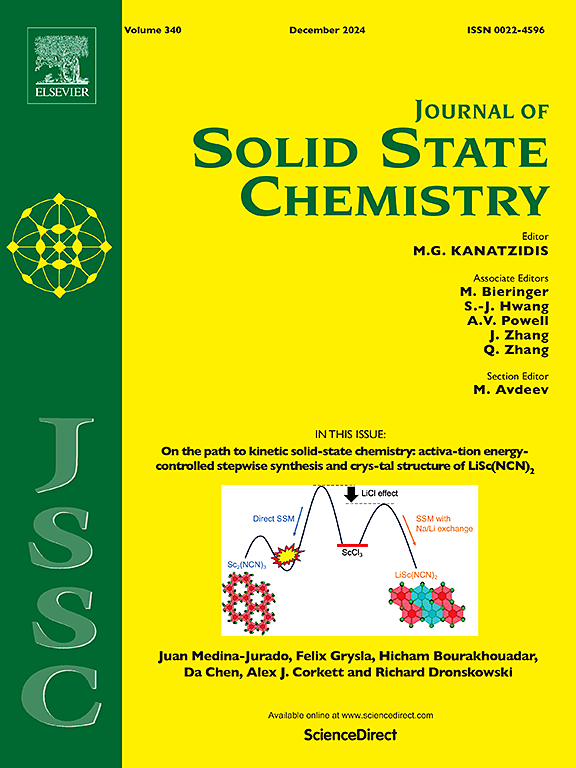在酸碱化学致密化过程中,Ba(OH)2 溶液浓度对获得 BaTiO3 体陶瓷的 Ba 离子扩散的影响
IF 3.2
3区 化学
Q2 CHEMISTRY, INORGANIC & NUCLEAR
引用次数: 0
摘要
本文章由计算机程序翻译,如有差异,请以英文原文为准。

Effect of Ba(OH)2 solution concentration on Ba ion diffusion in acid-base chemical densification process for obtaining BaTiO3 bulk ceramics
Near-room-temperature ceramic manufacturing are attracting attention as a way to reduce energy consumption and CO2 emissions. In this study, we have fabricated barium titanate (BaTiO3) bulk ceramics at near room temperature via acid-base chemical densification (ABCD) process, which utilizes the crystallization reaction that occurs between amorphous titania gel (TiO2·nH2O) and barium hydroxides (Ba(OH)2) aqueous solutions. The low temperature fabrication of bulk ceramics by ABCD process is based on the diffusion of cation ions into precursor pellets consisting of TiO2·nH2O and the crystallization of BaTiO3. In this study, focusing on concentration of Ba(OH)2 in aqueous solution, Ba diffusion behavior was evaluated in ABCD process. To prevent collapse due to the dissolution-precipitation reaction, the reaction temperature was set to 80 °C which is optimal temperature. When BaTiO3 prepared with high Ba(OH)2 concentration solution, such as 7.0 M, Ba ion is difficult to diffuse into a interior of the pellet sample because the dense crystallized BaTiO3 layer was formed immediately on the pellet surface which disturbs the penetration of Ba(OH)2 solution. In contrast, thick crystallized BaTiO3 layers were observed in the sample prepared in 0.4 or 0.7 M Ba(OH)2 solution. It was found that Ba ions diffusion was facilitated by reducing the Ba concentration in ABCD process because the crystallization rate can be suppressed using low concentration solution. However, when the Ba(OH)2 concentration was further reduced to 0.07 M, the Ba ions diffusing into the titania gel was low, so no BaTiO3 was formed. It was found that the optimal concentration of Ba(OH)2 can enhance the Ba diffusion in the pellets while maintaining crystallization into BaTiO3. In addition, by using a low-concentration barium solution, the dissolution-precipitation reaction can be suppressed even at high temperatures of 120 °C, so it was possible to create uniform BaTiO3 using ABCD process in 25 h. By reducing the barium concentration, it was possible to reduce the reaction time to 1/4 of the previous condition.
求助全文
通过发布文献求助,成功后即可免费获取论文全文。
去求助
来源期刊

Journal of Solid State Chemistry
化学-无机化学与核化学
CiteScore
6.00
自引率
9.10%
发文量
848
审稿时长
25 days
期刊介绍:
Covering major developments in the field of solid state chemistry and related areas such as ceramics and amorphous materials, the Journal of Solid State Chemistry features studies of chemical, structural, thermodynamic, electronic, magnetic, and optical properties and processes in solids.
 求助内容:
求助内容: 应助结果提醒方式:
应助结果提醒方式:


